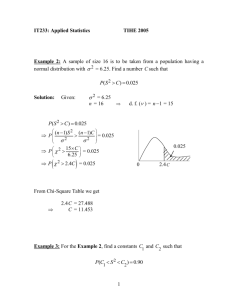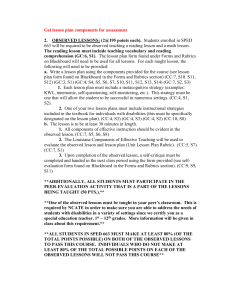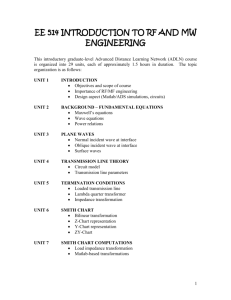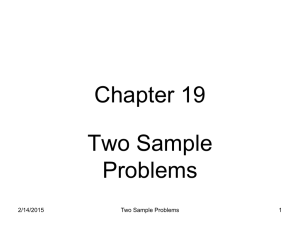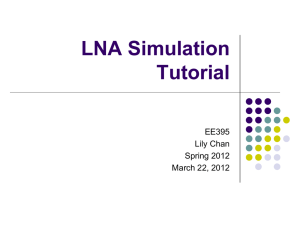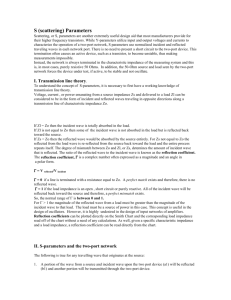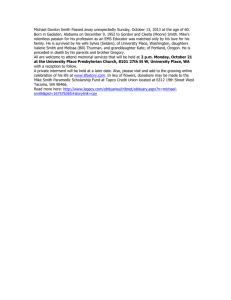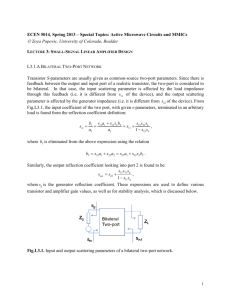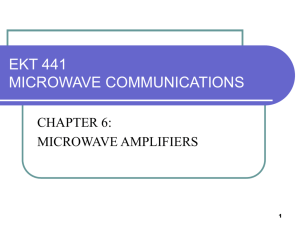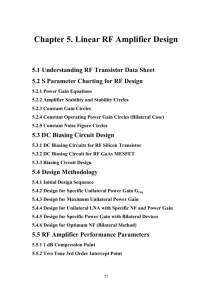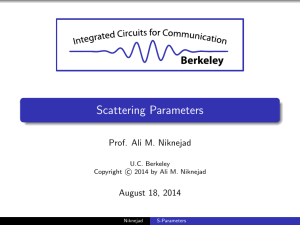S-Parameters and Smith Charts
advertisement
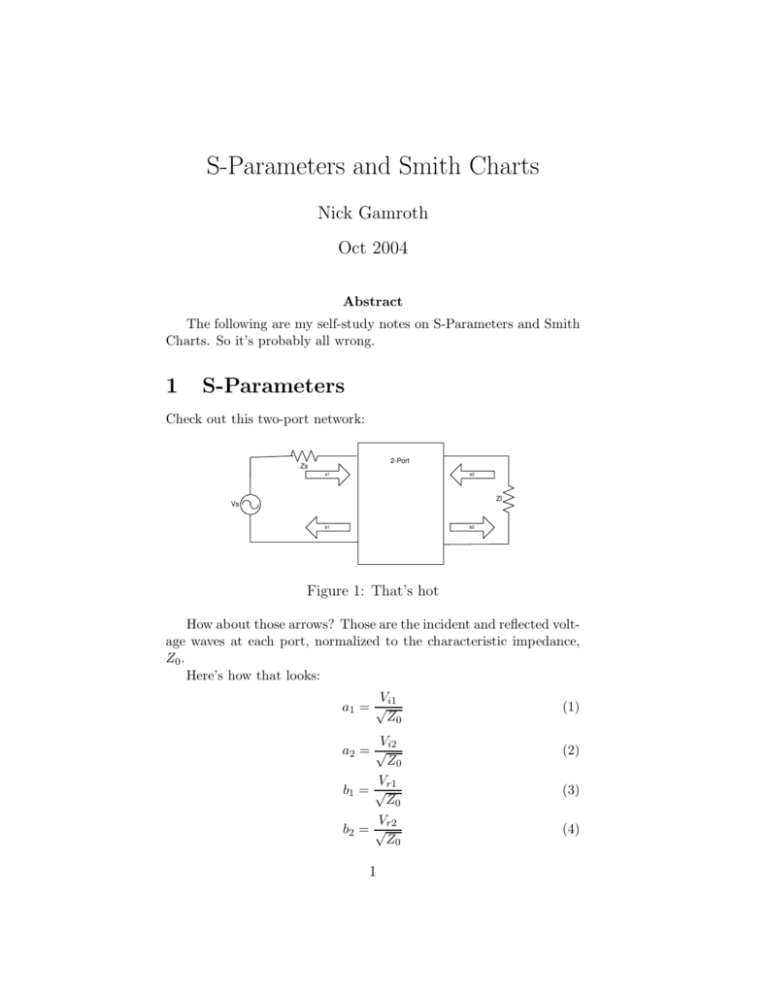
S-Parameters and Smith Charts Nick Gamroth Oct 2004 Abstract The following are my self-study notes on S-Parameters and Smith Charts. So it’s probably all wrong. 1 S-Parameters Check out this two-port network: 2-Port Zs a1 a2 Zl Vs b1 b2 Figure 1: That’s hot How about those arrows? Those are the incident and reflected voltage waves at each port, normalized to the characteristic impedance, Z0 . Here’s how that looks: Vi1 a1 = √ Z0 Vi2 a2 = √ Z0 Vr1 b1 = √ Z0 Vr2 b2 = √ Z0 1 (1) (2) (3) (4) Nicholas Gamroth Where, Vi1 = Voltage wave incident on port 1, Vi2 = Voltage wave incident on port 2, Vr1 = Voltage wave reflected from port 1, Vr2 = Voltage wave reflected from port 2. That’s OK, but it’s not that great. This is though: S11 = S22 S21 b1 a1 a2 =0 b2 = a2 a1 =0 b2 = a1 a2 =0 S12 = b1 a2 a1 =0 (5) (6) (7) (8) Wow. It’s not obvious to me why these are useful, but they are. S11 and S22 are input and output reflection coefficients, respectively. S11 is the input reflection coefficient with the output port terminated in a matched load, as in when ZL = Z0 , a2 − > 0. S22 is the output reflection coefficient when the input port is terminated in a matched load. S21 and S12 are the forward and reverse transmission gains, respectively with both being terminated in matched loads. I guess. 2 Reflection Coefficients Reflection coefficients are the same as in transmission lines. The have a complex and real part, and represent the quality of the impedance match between the load and the characteristic impedance of the line. Γ = Γr + jΓi = ZL − Z0 ZL + Z0 (9) Sometimes, folks normalize ZL , so you can write: Γ= ZL − 1 ZL + 1 Not too shabby. 2 (10) Nicholas Gamroth 3 Impedance and Admittance Remember impedance and admittance? I didn’t, so I wrote it down. It’s not that important for the purpose of this paper, but I think it’s something I ought to know. 3.1 Impedance Z = R + jX (11) Where Z =impedance, R =resistance, and X =reactance. For and inductor and a capacitor, X = jωL (12) 1 jωC (13) X= 3.2 Admittance Y = G + jB (14) Where Y =admittance, G =conductance, and B =susceptance. For and inductor and a capacitor, 1 jωL (15) X = jωC (16) X= 4 Smith Charts Now is when it gets hot. Check it out. In the Smith chart in figure 2, the blue circle segments are the circles of constant reactance, and the green circles are the circles of constant resistance. That’s the simplest explanation of a Smith chart I can find. You can plot things like a complex impedance on a Smith chart. Let’s try it. Z = 50 + j100 (17) First, normalize this complex impedance to 50Ω z = 1 + j2 (18) That was easy. The point right at the center of a Smith chart is the origin. Most charts give more detail that Figure 2, and they’ll have 3 Nicholas Gamroth Figure 2: YOW! things like numbers that you can use to plot things. So, the real part of z is the resistance, and the imaginary part is the reactance. To plot this complex number on the Smith chart, just go to 1 on the circle of constant resistance, and 2 on the circle of constant reactance. Simps! I did this on Figure 3. Point O is the origin, point A is the intersection of the circles of resistance 1 and reactance 2. Hmm, i wonder what the reflection coefficient of this complex resistance is? Ok, it’s Γ = 0.5 + j0.5, or in polar, 0.707/45deg, on most Smith charts, there’s a angle scale printed around the red circle in Figure 3. I’m not sure about the magnitude, but it appears to be the distance between OA and O to the red circle. Yeah, that’s it. But I don’t know a way to get it by visual inspection (with eyeballs). Here’s another tip: to plot something like 10 − j50, put that mess on the lower half of the chart. That’s where the X < 0 circles live. Actually, everything on the top half of a Smith chart represents inductance, and everything on the bottom half represents capacitance. As in an inductive or capacitive impedance. Oh yeah, and when you plot an impedance, it’ll change with frequency. So, if you have a RL circuit, it’s impedance on the smith chart will look like a line around one of the circles of constant resistance (because resistance doesn’t change with frequency, natch). Plus, it normally moves clockwise as frequency increases. That’s about it for plotting things on Smith charts. http://www.web-ee.com/primers/files/SmithCharts/smith charts.htm. 4 Nicholas Gamroth A R=1 X=2 O theta Figure 3: Plot it 5 Amplifier Stability Check out Figure 4. That’s a generalized amplifier setup. The S is the amplifier. You can use S-Parameters to figure out if the amplifier is unconditionally stable, and if it’s not, you can figure out when it is, and how to design source and load circuits to make it stable. s L Zs Vs Source Match S Load Match in Zl out Figure 4: Pump it up! People write S-Parameters in a matrix, like this: S S = 11 S21 S12 S22 (19) There are two important numbers that S-Parameters give you, 5 Nicholas Gamroth that can determine the stablility of an amplifier. The first one is the determinant of the S matrix and is called ∆. The second is K, which is given by the following formula: K= 1 + |∆|2 − |S11 |2 − |S22 |2 2 |S12 S21 | (20) If |∆| < 1 and K > 1, then the amplifier is unconditionally stable. Otherwise, you can create a stability circle to see when the amplifier is stable and when it’s not. For the output, the center of this circle is CL and the radius is RL CL = ∗ )∗ (S22 − ∆S11 |S22 |2 − |∆|2 S12 S21 RL = |S22 |2 − |∆|2 (21) (22) For the input, the center is CS and the radius is RS CS = ∗ )∗ (S11 − ∆S22 |S11 |2 − |∆|2 S12 S21 RS = |S11 |2 − |∆|2 (23) (24) These circles can be plotted on a Smith chart for added fun. Take a gander at Figure 5. Those got plotted using the equations just given. There’s a couple of conditions to determining whether or not the amplifier is stable. First, there’s a couple of parameters: D1 = |S11 |2 − |∆|2 (25) D2 = |S22 |2 − |∆|2 (26) D1 is associated with the source, and D2 is associated with the load. Depending on the sign of the D parameter, the stable region of the amplifier is either outside or inside the stability circle. For Dx > 0, the amplifier is stable outside of the stability circle, and for Dx < 0, the amplifier is stable inside the stability circle. If you look at Figure 5, and assume that D2 > 0, then we can say that for the load, the amplifier is stable for all regions that aren’t to the upper right of the arc labeled Load Stability Circle. If things go well, you’ll have a unconditionally stable amplifier. If this happens, depending on the Dx parameter, the stability circle will either be outside of the Smith chart, or completely encompass 6 Nicholas Gamroth Load Stability Circle Source Stability Circle Figure 5: Feet shoulder width apart for better stability it. If you see this, give yourself a pat on the back for making such a wonderful amplifier. Otherwise, don’t act so cocky. Since all that mess would be a hassle to calculate and draw, look at the S.J. Orfanidi reference to download a whole gang of MATLAB scripts to do it for you. That’s what I made the Smith chart graphics with, and it’s pretty easy to use. Mostly, you just have to put in the S-Parameters and it does the rest for you. 6 Unilateral Figure of Merit Here’s a little gem called the Unilateral Figure of Merit. U = ∗ S S S∗ | |S11 12 21 22 2 1 − |S11 | 1 − |S22 |2 (27) A lot of times, you don’t get a lot of reverse transmission, aka |S12 | << |S21 |. When this happens, you can call the two-port unilateral. Here’s gu : 1 gu = (28) |1 − U |2 7 Nicholas Gamroth gu is called the relative gain ratio, and if it’s near 1, you can probably treat the two-port as unilateral. A lot of things simplify somewhat in power calculations because you can set S12 == 0. 7 Power Gains When you make an amplifier, you want it to “plump up the volume” as much as possible. That doesn’t always happen if you just put in loads and sources all willy-nilly. You gotta think about that stuff. The first step in thinking about that stuff is figuring out how much gain you can get, and things like that. Theres three of these gains that tell you things like that. They’re all sort of messes, so I’m not going to write them down. I will list them though. They are: transducer power gain, GT , available power gain, Ga , and operating power gain, Gp . So, GT seems to be the most important, because it accounts for the effects of both the source and load impedances. What’s most important is that the transducer power gain is maximized when the two-port is simultaneously conjugate matched. That happens when Γin = Γ∗S and ΓL = Γ∗out . This also makes the three gains given above equal. This gain is called the maximum available gain. Looks like K ≥ 1 for this to happen. I’m mostly condensing this stuff from the Sophocles Orfanidis (what an awesome name) book listed in the references, so for more detail, take a look there. 8 Designing Matching Networks Now things might actually get useful, at least for amplifiers. We’ll see. So the big deal here is figuring out ΓS and ΓL to conjugate match the source and load. The next two equations are the long way to get this done: S12 S21 ΓL (29) Γ∗S = S11 + 1 − S22 ΓL Γ∗L = S22 + S12 S21 ΓS 1 − S22 ΓS (30) That’s not too bad, but if you look at it close, you get excited when you see what happens in the unilateral case (S12 = 0): ∗ ΓS = S11 (31) ∗ ΓL = S22 (32) 8 Nicholas Gamroth What could be easier? It’s possible to solve it in the bilateral case (bilateral is the opposite of unilateral, dude), but it involves some parameters I didn’t mention. They’re easy to get though, and the industrious reader will have no trouble figuring out how to solve the bilateral case. (Hint, they’re simultaneous equations.) C1 Zs Vs S L1 Load Match Zl Figure 6: It’s a match OK. Enough fooling around. Let’s design a matching network for a two-port. Look at figure 4. We’re going to design a source matching network that looks like Figure 6. There are other ways to do impedance matching, but I like circuits, so we’re going to use circuits. So, first we find the simultaneous conjugate match by using the equations above. Next, convert Γ to an impedance (we’re just doing the source side, so convert ΓS ). Now we have ZS which we convert to Zin by taking its complex conjugate. Finally, we just plug this Zin , along with our ZS into a couple of equations, and we’re done. Those equations are: (Note: Z = R + jX) Q= s XS2 RS −1+ RL RS RL (33) XS ± RS Q RS RL − 1 (34) X1 = X2 = − (XL ± RL Q) (35) OK, we’re not really done. The X’s from these equations are like complex impedances for the matching network, so we need to pick values for them. To pick the value for the inductor, use X1 like this: X1 (36) L= ω And to find the value for the capacitor, use X2 like this: 1 C=− (37) ωX2 Where ω is the frequency you’re running the circuit at. 9 Nicholas Gamroth 9 References Since I didn’t know anything about S-Parameters or Smith charts before I wrote this, it’s all plagarized. Most of it was taken from the following. S.J. Orfandis. Electromagnetic Waves & Antennas, Chapter 12. Draft available at www.ece.rutgers.edu/õrfanidi/ewa http://www.web-ee.com/primers/files/SmithCharts/smith charts.htm. 10
